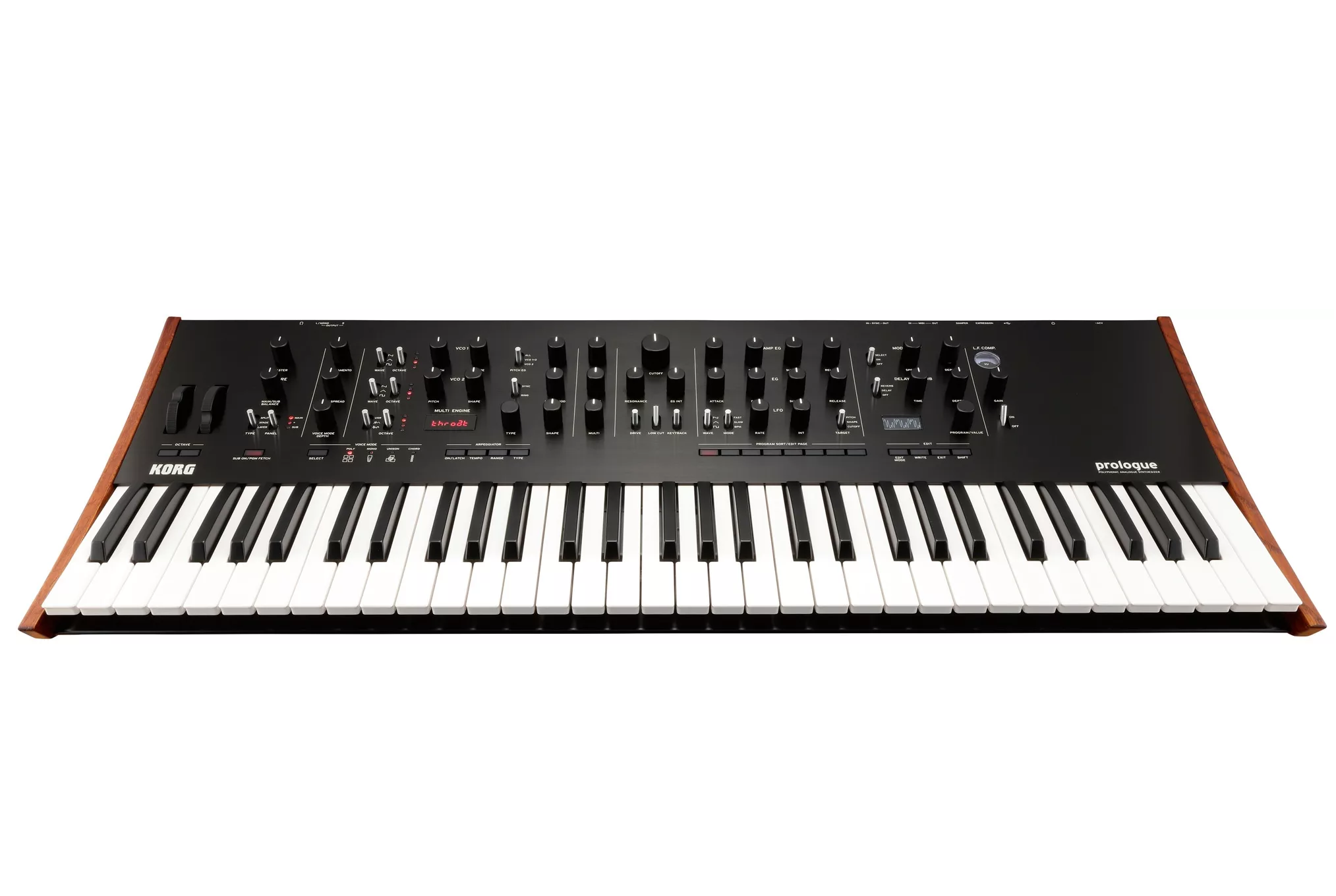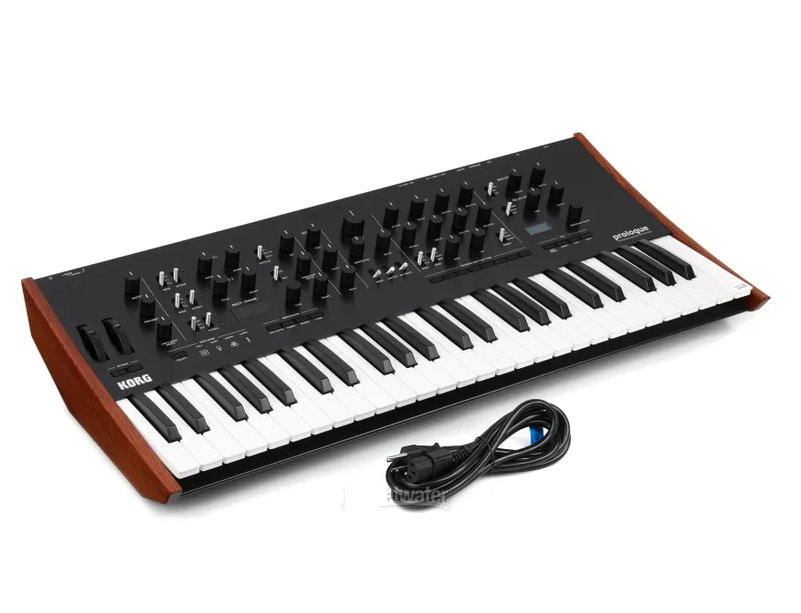Korg Prologue
Electronic Instruments
Asia
Between 1901 and present
Video
The Korg Prologue is a professional-grade polyphonic analog synthesizer designed to offer musicians and sound designers an extensive range of sonic possibilities. Developed by the renowned Japanese company Korg, the Prologue combines rich analog warmth with digital flexibility, making it a highly versatile instrument for both live performances and studio production. With its sleek design, robust construction, and intuitive interface, it appeals to both seasoned synthesists and newcomers looking for a powerful yet user-friendly instrument.
It is classified as a polyphonic analog synthesizer. More specifically, it is a hybrid synthesizer, blending traditional analog circuitry with digital components. Unlike monophonic synthesizers, which can only play one note at a time, the Prologue is capable of playing multiple notes simultaneously, making it suitable for complex harmonies and layered soundscapes. Its structure allows musicians to craft everything from deep bass lines to ethereal pads, making it an essential tool in various musical genres.
History
The Korg Prologue originates from Japan, a country in East Asia known for its significant contributions to electronic music technology. It was officially released in the 21st century, specifically in 2018. Japan has been at the forefront of synthesizer innovation since the late 20th century, with brands like Korg, Roland, and Yamaha shaping the modern music landscape.
Korg itself has a long history of developing influential synthesizers, starting in the 1960s. The Prologue follows in the footsteps of earlier Korg models such as the MS-20, Mono/Poly, and Minilogue, offering enhanced features and a more sophisticated design. The 21st-century evolution of analog synthesis, combined with digital advancements, has allowed instruments like the Prologue to push boundaries in sound design and usability.
Construction
The Korg Prologue is built with a solid metal chassis, giving it a sturdy and durable feel suitable for both studio and stage use. The instrument features high-quality wooden side panels that add a classic aesthetic touch, reminiscent of vintage analog synthesizers. The control panel consists of an array of knobs, switches, and buttons, providing hands-on control over sound shaping.
The Prologue comes in two versions: a 16-voice (Prologue-16) and an 8-voice (Prologue-8) model. Both models feature:
Two analog voltage-controlled oscillators (VCOs)
A digital multi-engine oscillator
A resonant low-pass filter
A variable shape wave modulation system
An arpeggiator and built-in effects
This combination of components allows users to create a diverse range of sounds, from lush atmospheric pads to aggressive leads.
Types
The Korg Prologue has two primary variants:
Prologue-8
Features 8-voice polyphony
Has a 49-key keyboard
Lighter in weight, making it more portable
Suitable for musicians who need a compact yet powerful analog synth
Prologue-16
Features 16-voice polyphony
Has a 61-key keyboard
Includes an additional low-frequency oscillator (LFO)
Designed for professional musicians and producers requiring a broader tonal range
Both models share the same core sound engine, but the increased polyphony and extended keyboard of the Prologue-16 offer enhanced creative possibilities.
Characteristics
The Korg Prologue is a professional-grade polyphonic analog synthesizer, available in 8-voice (Prologue-8) and 16-voice (Prologue-16) configurations. It features a fully analog signal path with two VCOs per voice, a multimode filter, and a built-in digital effects section, providing a rich and versatile sound. One of its standout features is the third digital oscillator (Multi Engine), which offers noise, VPM/FM synthesis, and user-programmable oscillators, expanding its sonic capabilities beyond traditional analog synths.
The arpeggiator, built-in compressor (Prologue-16 only), and customizable user slots further enhance its performance and sound design potential. It sports a sleek aluminum panel with wooden side panels, giving it a premium look, and its 49-key (Prologue-8) or 61-key (Prologue-16) keybed ensures a responsive playing experience. With MIDI, USB, and CV inputs, it integrates well into modern setups, making it a powerful tool for live performances and studio production.
Sound Production
The Prologue generates sound through a combination of analog and digital components. The primary sound sources include two analog voltage-controlled oscillators (VCOs) and a third digital oscillator, known as the multi-engine. This hybrid design allows for a vast range of sonic textures.
The synthesizer’s sound is further shaped using a voltage-controlled filter (VCF), envelope generators, and low-frequency oscillators (LFOs). The onboard effects engine provides high-quality digital reverbs, delays, and modulation effects, adding depth and character to the sound.
Playing Methods
The Korg Prologue is a professional polyphonic analog synthesizer that offers multiple playing methods to suit different styles and performance needs. As a fully-programmable instrument, it allows musicians to play using a standard keyboard interface with velocity sensitivity, making expressive playing possible. The synthesizer features a dual-timbre mode, enabling layering or splitting sounds across the keyboard for dynamic performances. Additionally, its polyphonic architecture supports both poly and mono playing styles, while the arpeggiator function provides rhythmic movement to notes, allowing for complex patterns and sequences.
The Prologue also includes a unique digital Multi-Engine, which introduces FM synthesis and wavetable oscillators, expanding the range of sound design options. With real-time controls such as knobs, sliders, and a modulation wheel, performers can shape the sound intuitively while playing, making it a versatile instrument for live performance and studio production.
Roles in Music
The Korg Prologue plays a significant role in many music genres, including electronic, ambient, rock, jazz, and experimental music. Some common applications include:
Lead Synthesizer: Used for melody lines and solos.
Bass Synth: Capable of deep, resonant bass sounds.
Pads and Textures: Ideal for creating lush backgrounds and atmospheric elements.
Arpeggiated Sequences: Adds rhythmic and harmonic movement to compositions.
Effects and Sound Design: Used in film scoring, game music, and experimental projects.
Cultural Significance
Synthesizers like the Korg Prologue have played a crucial role in shaping modern music culture. Since the late 20th century, Japan has been a hub for electronic music innovation, and Korg has been at the forefront of this movement. The Prologue, with its hybrid synthesis engine, reflects the evolution of analog synthesis in the digital era.
The Prologue is used by a diverse range of musicians worldwide, from electronic music producers to rock bands. Its versatility makes it a staple in music production, live performance, and experimental sound design. As music technology continues to evolve, instruments like the Prologue bridge the gap between traditional analog synthesis and modern digital innovation.
The Korg Prologue is a powerful and expressive instrument that embodies the best of both analog and digital synthesis. Its high-quality construction, versatile sound engine, and extensive performance capabilities make it a valuable tool for musicians and producers. Whether used for live performances, studio recordings, or sound design, the Prologue stands as a testament to Korg’s legacy of synthesizer innovation. As the demand for hybrid synthesis continues to grow, the Prologue remains a sought-after instrument in the world of music technology.
FAQ
What are the key features of the Korg Prologue?
The Korg Prologue is a hybrid analog-digital synthesizer with 8 or 16-voice polyphony. It features two VCOs per voice, a digital multi-engine, a powerful effects section, and an open-source SDK for custom oscillators and effects.
What kind of music is the Korg Prologue best suited for?
The Korg Prologue excels in electronic, ambient, synthwave, and experimental music. Its rich analog tones, digital multi-engine, and deep modulation options make it perfect for lush pads, evolving textures, and powerful leads.
What makes the Korg Prologue's sound unique?
The Prologue's hybrid design combines warm analog oscillators with a versatile digital multi-engine. Its custom oscillator capabilities and deep effects section allow unique, evolving timbres not found in traditional analog synths.
 Links
Links
References
Other Instrument
Categories



















